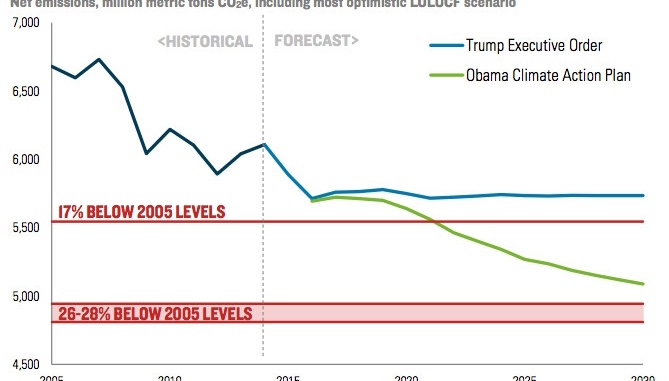
By Michael Beeli
Copy Editor
Tumblr Photo Essays-(Climate Order Threatens Environment)
Barack Obama’s environmental legacy was targeted by President Trump on March 28 in a sweeping new executive order that called for the repeal of several key Obama-era climate regulations. The order indiscreetly rolls back signature achievements of United States’ environmental policy from the past eight years, posing significant risks to global stability, the United States’ economy and national security, consequently threatening the environmental integrity of the community.
The first and most significant step of Trump’s executive order was to set the stage for the repeal of the 2015 Clean Power Plan, Obama’s central climate policy. The Clean Power Plan seeks to mitigate the effects of climate change by reducing the United States’ annual carbon emissions to 32% lower than 2005 levels by 2032. Key to the plan’s relative success thus far has been the fact that it has set individual emissions reduction goals for 47 different states, and it authorizes the Environmental Protection Agency to enact cap-and-trade federal carbon plans on states that refuse to comply with EPA-approved standards.
While Trump’s order doesn’t directly repeal the Clean Power Plan, it essentially instructs EPA head and climate change skeptic Scott Pruitt to replace the Clean Power Plan with an alternative ordinance, but has not provided any indication as to what the replacement plan would entail. The appointment of Pruitt, who has sued the EPA 13 times over climate change regulations as Oklahoma’s attorney general, is just short of hiring a fox to guard the hen house; his past views on climate clearly indicate that any replacement he proposes to the Clean Power Plan will favor corporate deregulation and will do little, if anything, to slow down the worst effects of climate change.
The second step of Trump’s order calls for Pruitt to revise some EPA standards for new coal plants. The 2013 standards require any new coal and natural gas plants to limit carbon dioxide emissions to less than 1,100 pounds of carbon dioxide per-megawatt-hour, more than 600 pounds of CO2 per-megawatt-hour above the national average for coal plants in the United States. Trump’s team will reportedly look into altering these rules so that “a lot of coal miners will be going back to work,” Trump said at a campaign rally in Louisville, Kentucky on March 24.
Despite Trump’s promises, the direction of the U.S. economy appears to be heading away from coal production as a result of market forces. According to the Energy Information Agency, coal production fell 18% from the previous year, while natural gas production has been steadily increasing since 1990, meaning that the trend is not a result of Obama-era regulation. Trump’s order evidently reflects either a delusional or deliberately misleading promise to America’s disenfranchised coal workers and simultaneously threatens global efforts to reduce the worst effects of climate change. As a result, it is evident that Trump’s pledges to stimulate the coal industry are not only environmentally negligent but also economically senseless.
Firsthand analysis on why coal is being phased out of the US economy
Trump’s active targeting of sensible climate policy comes with grave repercussions across the entire planet. According to the Climate Vulnerable Forum, a partnership of developing nations threatened by climate change, if emissions levels are not reduced by at least 26% or greater by 2030, up to 100 million people globally could lose their lives, and global Gross Domestic Product (GDP) could fall as much as 3.2%. According to the report, more than 90% percent of the deaths would result from the human and economic impact of climate change. Trump’s executive order’s deliberate negligence of the catastrophic consequences of climate change is deeply troubling, as it indicates his eagerness to disregard critical research of the scientific community and prioritize short-term profits over global growth and stability.
Although Trump’s order did not call for the United States to withdraw from the 2015 Paris Climate Accords, as many expected, the text of the order indicates that Trump has no intention of upholding the pledge of cutting greenhouse gas emissions by 26% by 2030, the central provision of the accords. According to the Rhodium Group, a global policy think tank, the provisions of the executive order will fail to reduce U.S. emissions by even 17%.
The 9% disparity in emissions means that Trump’s plan will permit over 500 million metric tons more of carbon to be released from the United States by 2030. Under the current Environmental Protection Agency’s estimated social cost of carbon standard of $36 per ton, the total social cost of carbon as a result of the order will be $18 billion by 2030 as a result of the executive order.
Stanford research on why the current social cost of carbon is too low
The climate order also contradicts local grassroots efforts toward progressive policies in the community. The Redondo Beach City Council is set to vote on the South Bay Clean Power Community Choice Aggregation plan in the coming months, a proposal that, according to the South Bay Clean Power plan, will prioritize the development of renewable energy resources so that consumers may choose to have 33%, 50% or 100% of their total power be derived from renewable sources, as opposed to the maximum 28% currently offered by Southern California Edison.
The SBCCA represents a concerted local community effort to lead the shift to renewable and cleaner energy; however, Trump’s destructive stance of climate change denial has empowered and energized further opposition to the plan. At a March 21 Redondo Beach City Council meeting, Beach Cities Republican Club leader Arthur Schaper decried the plan, proclaiming the plan was “another government subsidy propping up alternative energy” and “a waste of money and time,” according to the Redondo Beach City Council March 21 meeting transcript.
According to South Bay Clean Power, a citizens working group focused on progressive energy policy, citizens all across the South Bay region are advocating the adoption of Clean Power Plans in their respective cities. In addition to Redondo Beach’s consideration of the SBCCA, the Torrance City Council recently voted 6-1 on April 4 to review and consider the South Bay Clean Power Business plan, the SBCCA’s legislative profile for the development of clean and renewable power sources.
These cities’ efforts to pioneer clean energy development demonstrate the awareness and advocacy of the local community that takes global crises seriously. The South Bay is rapidly becoming a global leader in the energy revolution; it is high time the presidential administration leads the way forward, not backward, on climate activism.




Leave a Reply